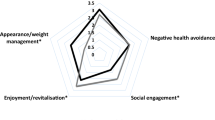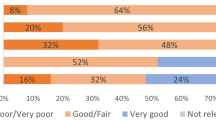Abstract
Study Design:
Cross-sectional.
Objectives:
To examine patterns of participation in activities of daily living (ADL) and fitness-related factors associated with these patterns among individuals with spinal cord injury (SCI).
Setting:
Centre for Health Promotion and Rehabilitation at McMaster University, School of Kinesiology and Health Studies at Queen's University.
Methods:
Forty-eight participants completed the Physical Activity Recall Assessment for People with Spinal Cord Injury (PARA-SCI) and a fitness test assessing cardiovascular fitness (VO2max and peak power output (Po)). The most commonly reported ADL were extracted from the PARA-SCI data for analysis.
Results:
Women tended to spend more time participating in domestic and personal care ADL than men. Compared to individuals with tetraplegia, individuals with paraplegia tended to spend more time transferring, cleaning and preparing food and less time wheeling, toileting and dressing. Fitness and participation in leisure time physical activity (LTPA) were associated with certain ADL. Participants with higher levels of fitness spent more time partaking in ADL wheeling and cleaning. Moreover, greater time spent participating in moderate- and heavy-intensity LTPA was positively correlated with time spent engaged in certain ADL.
Conclusion:
By identifying common ADL performed by individuals with SCI, the study findings begin to provide direction for developing strategies to optimize ADL participation. Future research should examine fitness as a way to help individuals with SCI optimize their ADL participation.
Similar content being viewed by others
Log in or create a free account to read this content
Gain free access to this article, as well as selected content from this journal and more on nature.com
or
References
World Health Organization. International Classifications of Functioning, Disability And Health: ICF. WHO: Geneva, 2001.
Pentland W, Harvey AS, Smith T, Walker J . The impact of spinal cord injury on men's time use. Spinal Cord 1999; 37: 786–792.
Schonherr MC, Groothoff JW, Mulder GA, Eisma WH . Participation and satisfaction after spinal cord injury: results of a vocational and leisure outcome study. Spinal Cord 2005; 43: 241–248.
Yerxa EJ, Locker SB . Quality of time use by adults with spinal card injuries. Am J Occup Ther 1990; 44: 318–326.
Maynard Jr FM, Bracken MB, Creasey G, Ditunno Jr JF, Donovan WH, Ducker TB et al. International standards for neurological and functional classification of Spinal Cord Injury. American Spinal Injury Association. Spinal Cord 1997; 35: 266–274.
Biering-SØensen F, Hansen RB, Biering-Sørensen J . Mobility aids and transport possibilities 10–45 years after spinal cord injury. Spinal Cord 2004; 42: 699–706.
Latimer AE, Ginis KA, Craven BC, Hicks AL . The physical activity recall assessment for people with spinal cord injury: validity. Med Sci Sports Exerc 2006; 38: 208–216.
Carpenter C, Forwell SJ, Jongbloed LE, Backman CL . Community participation after spinal cord injury. Arch Phys Med Rehabil 2007; 88: 427–433.
Janssen TW, van Oers CA, Veeger HE, Hollander AP, van der Woude LH, Rozendal RH . Relationship between physical strain during standardised ADL tasks and physical capacity in men with spinal cord injuries. Paraplegia 1994; 32: 844–859.
Janssen TW, van Oers CA, van der Woude LH, Hollander AP . Physical strain in daily life of wheelchair users with spinal cord injuries. Med Sci Sports Exerc 1994; 26: 661–670.
Hicks AL, Martin KA, Ditor DS, Latimer AE, Craven C, Bugaresti J et al. Long-term exercise training in persons with spinal cord injury: effects on strength, arm ergometry performance and psychological well-being. Spinal Cord 2003; 41: 34–43.
Hoffman MD . Cardiorespiratory fitness and training in quadriplegics and paraplegics. Sports Med 1986; 3: 312–330.
Jacobs PL, Nash MS . Exercise recommendations for individuals with spinal cord injury. Sports Med 2004; 34: 727–751.
Martin Ginis KA, Latimer AE, Hicks AL, Craven BC . Development and preliminary evaluation of an activity measure for people with spinal cord injury. Med Sci Sports Exerc 2005; 37: 1099–1111.
Bizzarini E, Saccavini M, Lipanje F, Magrin P, Malisan C, Zampa A . Exercise prescription in subjects with spinal cord injuries. Arch Phys Med Rehabil 2005; 86: 1170–1175.
Cohen J . A power primer. Psychological Bulletin 1992; 112: 155–159.
Zambraski EJ . Renal regulation of fluid homeostasis during exercise. In: Gisolfi CV, Lamb DR (eds). Perspectives in Exercise Science and Sports Medicine. Vol. 3, Fluid Homeostasis During Exercise. Benchmark Press: Indianapolis, 1990.
Westerterp KR, Plasqui G, Goris AHC . Water loss as a function of energy intake, physical activity and season. Br J Nutr 2005; 93: 199–203.
Oettle GJ . Effect of moderate exercise on bowel habit. Gut 1991; 32: 941–944.
Acknowledgements
Research supported by Canadian Institutes of Health Research (CIHR) Grant no. MOP-57778 awarded to Kathleen Martin Ginis.
Author information
Authors and Affiliations
Corresponding author
Rights and permissions
About this article
Cite this article
Hetz, S., Latimer, A. & Martin Ginis, K. Activities of daily living performed by individuals with SCI: relationships with physical fitness and leisure time physical activity. Spinal Cord 47, 550–554 (2009). https://doi.org/10.1038/sc.2008.160
Received:
Revised:
Accepted:
Published:
Issue date:
DOI: https://doi.org/10.1038/sc.2008.160
Keywords
This article is cited by
-
Advanced weight-bearing mat exercises combined with functional electrical stimulation to improve the ability of wheelchair-dependent people with spinal cord injury to transfer and attain independence in activities of daily living: a randomized controlled trial
Spinal Cord (2020)
-
Type, intensity and duration of daily physical activities performed by adults with spinal cord injury
Spinal Cord (2017)
-
A description and estimate of very low-intensity activity and inactive awake time in community-dwelling adults with chronic spinal cord injury
Spinal Cord (2016)
-
A more active lifestyle in persons with a recent spinal cord injury benefits physical fitness and health
Spinal Cord (2012)



